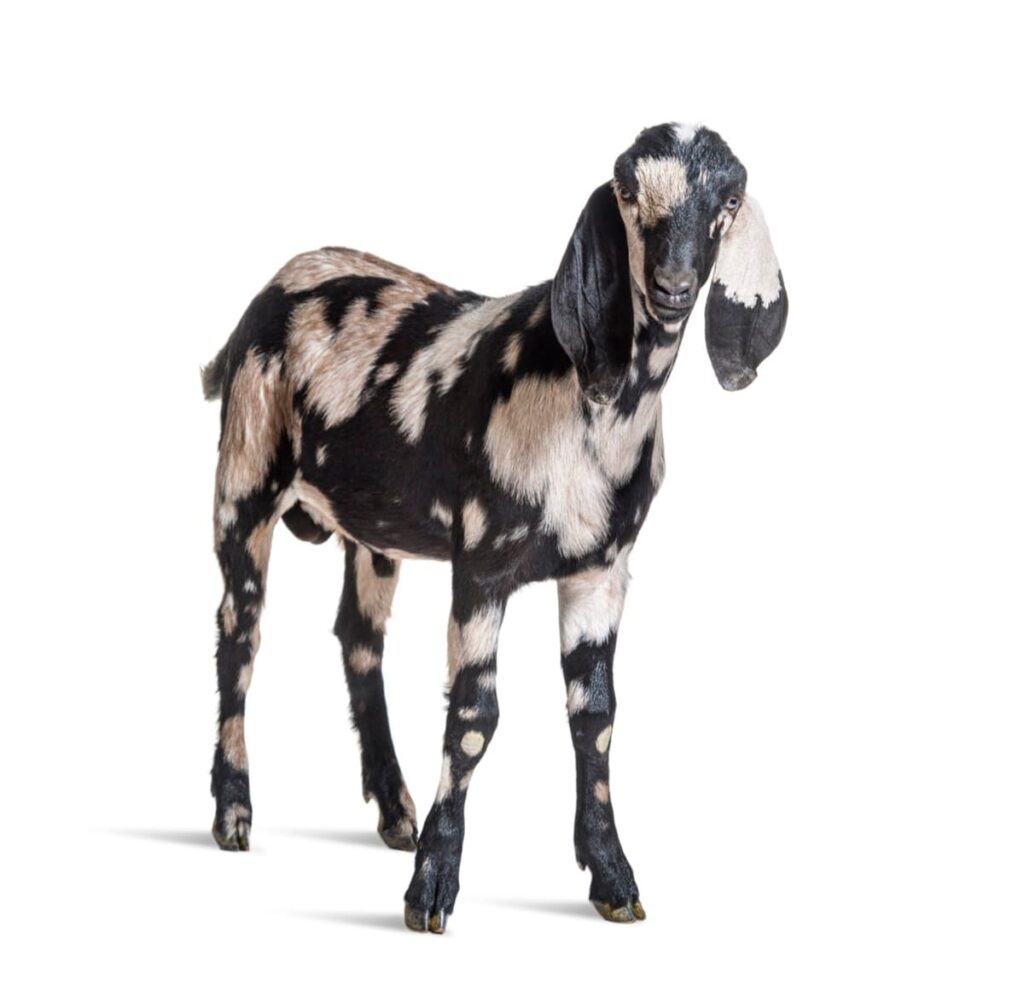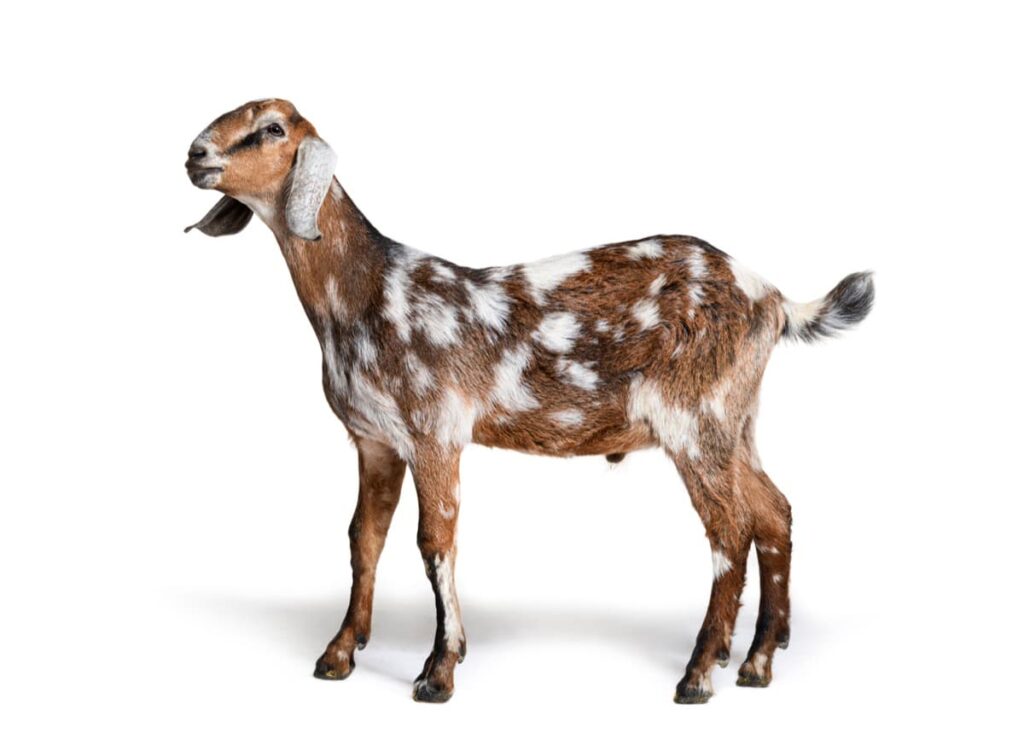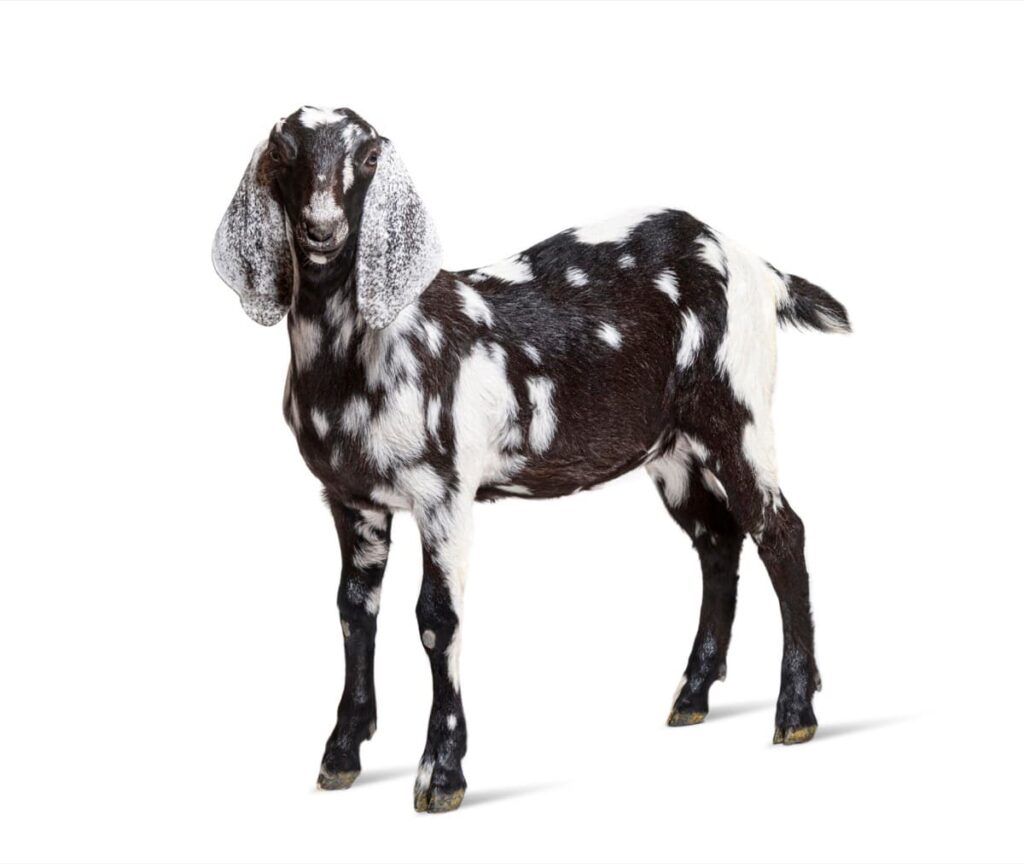Anglo-Nubian goat farming is a popular practice among farmers worldwide. These goats are known for their high milk production and are easy to rear. They are needed for both commercial and domestic purposes. Anglo-Nubian goats have a distinctive appearance, with long drooping ears and a convex nose. They are adaptable to various climatic conditions and can be kept in different environments, including small backyard spaces. They require minimal care, and their highly nutritious milk makes them an ideal choice for dairy farmers.

Anglo-Nubian Goat Farming
Characteristics of Anglo-Nubian Goats
- Physical appearance: Anglo-Nubian goats are large with long legs, a convex facial profile, and long, drooping lop ears. They may be polled (without horns) or have small downward-curved horns. The coat is short and smooth in nannies but rougher and longer in billies. They come in different colors, including white, cream, fawn, chestnut, and black, often in brindled, marbled, or mottled patterns.
- Uses: Anglo-Nubian goats are dual-purpose animals, meaning they are raised for both meat and dairy. They are known for their high-quality milk, which is relatively high in butterfat and protein and can be used to make cheese, yogurt, and other dairy products. They are also valued for their meat, which is tender and flavorful.
- Weight and height: Male Anglo-Nubian goats can weigh up to 140 kg (310 lb) and have an average height of 90 cm (35 in). Female goats are smaller, with an average height of 80 cm (31 in) and a maximum weight of 110 kg (240 lb).
- Wool color: Anglo-Nubian goats can have variable wool colors, but the most common colors are black, chestnut, cream, fawn or white, often with patterns.
- Horn status: Anglo-Nubian goats can either be polled or have small horns. The horned variety is preferred in some countries for showing purposes.
History and Origin of Anglo-Nubian Goats
- Country of origin: The Anglo-Nubian goat was developed in the United Kingdom by crossing British goats with bucks of African and Indian origin in the late 19th century.
- Distribution: The breed is now widely distributed throughout more than sixty countries worldwide and is particularly popular in the United States.
Use of Anglo-Nubian Goats
- Anglo-Nubian goats are popular among farmers due to their dual-purpose use for meat and milk production. The kids of this breed grow quickly and are ideal for meat production.
- Although the milk yield is not as high as some Swiss goat breeds, it has a higher fat percentage, making it ideal for cheese and butter production. On average, a nanny Anglo-Nubian goat produces approximately 3.9 kg of milk daily with a fat content of around 4.8%.
- The breed also boasts impressive milk yield records, with the highest recorded 24-hour yield being 8.25 kg and the highest authenticated annual yield of over 2500 kg.
How to Start Anglo-Nubian Goat Farming
- Conduct thorough research: Learn as much as possible about the breed, their requirements, and the market demand for their products.
- Choose a suitable location: Anglo-Nubian goats require adequate space, shelter, and grazing land. Ensure that the location has easy access to water and electricity.
- Acquire healthy goats: Purchase healthy, purebred Anglo-Nubian goats from a reputable breeder. It is advisable to start with at least two females and one male.
- Build appropriate housing: Construct a suitable shelter for your goats to protect them from extreme weather conditions and predators.
- Provide proper nutrition: Provide a balanced diet that meets the nutritional requirements of your goats. Anglo-Nubian goats require good-quality hay, grains, and fresh water.
- Establish a breeding program: Develop a breeding program to ensure the sustainability of your Anglo-Nubian goat farm. Keep accurate breeding records and select healthy and productive animals for breeding.
- Market your products: Develop a marketing plan to sell your goat milk, meat, and fiber products. Consider direct sales to local consumers or through farmers’ markets, online sales, or partnering with local restaurants.
In case you missed it: Goat Breeding and Genetics for Improved Productivity and Disease Resistance

Feeding in Anglo-Nubian Goats
- The Anglo-Nubian goats are known for their excellent grazing ability and preference for leaves, grasses, and grains.
- Additional nutritious feeds are required in confined conditions or stall-fed systems for proper growth and maximum production.
- Ready-made goat feed can be purchased or prepared at home for the goats.
- Breeding bucks, pregnant should be provided with special food to meet their specific nutritional requirements.
- Ample clean, fresh water should be provided to the goats according to their demand for optimal health and performance.
Housing for Anglo-Nubian Goats Farming
- Anglo-Nubian goats prefer a dry place for living, so building a raised house is recommended.
- A deep litter system can also be used, but keep dry straw/hay or sand on the floor.
- A good ventilation system with sufficient fresh air and light flow is important.
- If raising goats in a stall-fed system, enough feeding and watering equipment should be kept inside the house and cleaned regularly.
- A medium to large-sized goat breed like Anglo-Nubian requires 12-15 square feet of space per goat.
- If raised in a stall-fed system, double the playing space should be provided compared to the living space.
Breeding, Care & Management in Anglo-Nubian Goats Farming
- Always provide clean and fresh water and ensure that their feed is good quality. Regularly clean their living area and ensure it is free from parasites and predators.
- Anglo-Nubian goats require regular grooming, especially their hooves, which need trimming every few months. This helps to prevent infections and other foot problems.
- Breeding season for Anglo-Nubian goats usually starts in the autumn and lasts until the winter. Select healthy and well-bred bucks and does for breeding.
Anglo-Nubian Goat Farming for Profit
- Anglo-Nubian goats, also known as Nubian goats, are a breed of domestic goats known for their high milk production, meat quality, and distinct physical characteristics.
- Anglo-Nubian goats are originally from England but are now widely raised in various countries worldwide, including the United States, Australia, and South Africa.
- Anglo-Nubian goats are medium to large-sized animals with long ears, a Roman nose, and a sleek coat that can come in various colors.
- These goats are known for their high milk production, with an average yield of 3 to 4 liters per day and a fat milk content of around 4.5% to 5%.
- Anglo-Nubian goats are also popular for their meat, with a carcass that can yield a high percentage of meat compared to other goat breeds.
- Anglo-Nubian goats are adaptable and can thrive in a variety of climates, making them suitable for different regions around the world.
- Anglo-Nubian goat farming can be profitable through effective management practices, such as providing proper nutrition, good healthcare, and optimizing breeding strategies.
- Market demand for Anglo-Nubian goat products, such as milk and meat, is growing due to their high quality and nutritional value.
- Anglo-Nubian goat farming can also generate additional income by selling breeding stock, as the breed is sought after for improving milk production and meat quality in other goat herds.
Common Diseases and Health Issues
- Gastrointestinal disorders: Anglo-Nubian goats are prone to gastrointestinal issues such as bloat, diarrhea, and constipation. These can be caused by overeating, consuming spoiled or moldy feed, or sudden diet changes.
- Respiratory infections: Goats, including Anglo-Nubians, can be susceptible to respiratory infections like pneumonia. This can occur due to exposure to cold or damp environments, overcrowding, or poor ventilation.
- Parasitic infestations: Internal and external parasites such as worms, mites, and lice can affect Anglo-Nubian goats. These can lead to poor growth, weight loss, anemia, and skin irritations.
- Foot problems: Goats, including Anglo-Nubians, can suffer from foot issues like foot rot and hoof abscesses. Wet and muddy conditions, poor hoof hygiene, or injury can cause these. Regular hoof trimming, keeping their living area clean and dry, and avoiding sharp objects can help prevent foot problems.
- Reproductive issues: Anglo-Nubian goats can face reproductive problems such as infertility, difficult labor, and retained placenta. These can be caused by poor nutrition, genetic factors, or inadequate management practices during pregnancy and kids.
- Metabolic disorders: Goats, including Anglo-Nubians, can suffer from metabolic disorders such as ketosis, hypocalcemia, and acidosis. These can occur due to imbalanced diets, stress, or other factors that disrupt their metabolic processes.
In case you missed it: Innovative Housing and Shelter Designs for Profitable Goat Farming

Conclusion
Anglo-Nubian goats are a popular breed for farming due to their high milk yield, adaptability to various climates, and friendly temperament. Proper care, nutrition, and housing are essential for their health and productivity. Farmers should also know common health issues and breeding considerations to maintain a successful herd.
- Types of Grass Growing for Goat Farm
- How to Train Goats for Milking: A Beginners Guide
- Goat Milking Practices and Equipment: A Beginner’s Guide
- Goat Farming for Fiber: Producing Mohair and Cashmere
- Maximizing Goat Milk Production: Tips for Dairy Goat Farmers
- Goat Farming as a Family Business: Strategies for Success
- Profitable Kenya Goat Breeds for Commercial Dairy and Meat Business
- Unlock the Secrets of Oberhasli Goat: Discover Raising and Management Practices
- Ultimate Guide to Myotonic Goats: Explore Profile to Raising
Who sells Nubian goat kid in Kerala?
request for artificial insemination in Anglo-Nubian?
I am very much impressed with the goat and the brief summary about them; I invested in sheep farming, and I would like to increase my capacity to goat Farming. My Farm is located in The Gambia(West Africa). how can I get those types of high bread goats in my country?
what is the average wt. of 3 months old pure bred island born
anglo nubian goats? and its selling price